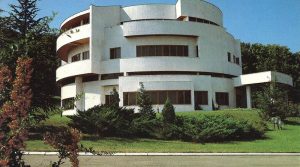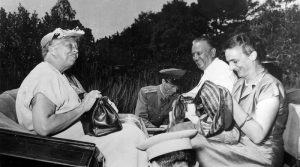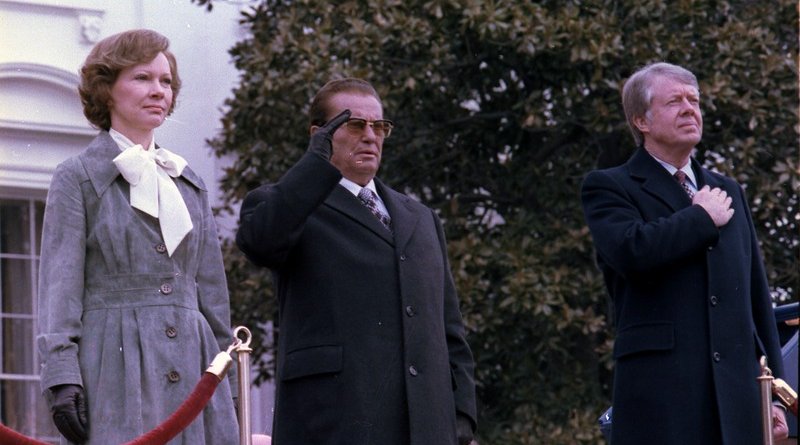Tito’s Legacy: Surveying The Yugoslav Leader’s Real Estate – Analysis
Opulent villas, island retreats, hunting lodges and yachts: Josip Broz Tito’s many properties were scattered across the republics of the former Yugoslavia – although some have fallen into disrepair since the state collapsed.
By Milica Stojanovic, Samir Kajosevic, Anja Vladisavljevic and Mladen Lakic
Yugoslav leader Josip Broz Tito used many residences and holiday homes during the long period of his rule from 1944 until his death in 1980.
The Communist president enjoyed a luxury lifestyle while in office, and when he died, his possessions were estimated to be worth dozens of millions of euros. The issue of who should inherit his assets resulted in a legal dispute which continues to this day.
Some of Tito’s properties have since been sold off or rented out, but others are still popular attractions for Yugo-nostalgic tourists, like the House of Flowers in Belgrade, where he is buried, or his villa in his home village of Kumrovec in Croatia, where his birthday is celebrated by his admirers each year.
Serbia: Milosevic moves in
After World War II and the liberation of Belgrade, Tito moved to the Serbian capital and lived in a villa at 15 Uzicka Street in the upmarket Dedinje district of the city.
During WWII, the villa, which was built in 1934, had been used by German commanders until it was occupied by the Yugoslav Partisans. The commander of the Partisan forces, Peko Dapcevic, led the final operation for the liberation of Belgrade from the villa. From 1946 until 1979, it became Tito’s home.

Tito also lived at some point after the war in the Beli Dvor (White Palace), the property of the former royal family of Yugoslavia, which was completed in 1937. When he came to Belgrade, he brought his long-standing personal assistant and allegedly greatest love, Davorjanka Paunovic. She died in 1946 and was buried within the palace complex.
The complex is now the property of the state, but the Karadjordjevic family, Serbia’s former royal dynasty, is allowed to use it. It is open to visitors.
In 1979, another villa was built nearby, at 11 Uzicka Street, later called Villa Mir (Peace), but Tito never moved in.
After his death, the two villas on Uzicka Street, a winter garden (later called the House of Flowers, where Tito and his wife are buried), two museums and a couple of other buildings became the Josip Broz Tito Memorial Centre. The House of Flowers and the Tito Memorial Centre are now part of the Museum of Yugoslavia, which remains a popular site for tourists.
After the election in 1997, when Slobodan Milosevic became president of Yugoslavia, he and his family moved into the villa at 15 Uzicka Street. They lived there until April 1999, when the building was hit during the NATO bombing of Yugoslavia and seriously damaged.
The Milosevic family then moved into the other villa at 11 Uzicka Street, which at that time contained a lot of Tito’s property. After he was deposed, Milosevic was arrested there in 2001 and subsequently sent to The Hague to stand trial for wartime crimes.
Today, the villa at 15 Uzicka Street is designated for the use of state representatives, while 11 Uzicka Street is classified as a ‘residency’, and can be used for receptions by the president or prime minister or to host high-level foreign guests.
After Tito died, his widow Jovanka was transferred to another villa on Peace Boulevard (now Prince Alexander Karadjordjevic Boulevard) in Dedinje, where she lived until her death in 2013. She rarely left the house, which was in very poor condition.
The house has the same status as the villa at 15 Uzicka Street, but according to media reports, the state can’t afford to renovate it.
Another complex in Karadjordjevo, a village near Backa Palanka in northern Serbia, was used by the Yugoslav government and then in 1973 was given to the Yugoslav People’s Army, but was considered to be Tito’s because he spent a lot of time there – mostly hunting, but also receiving high-profile foreign guests.
Tito’s private property was initially declared to be the property of the state after he died, but that ruling was declared unconstitutional in 2000. The court case over the rights to his legacy is still ongoing.
In 2013, Serbia’s then president Tomislav Nikolic set up a commission to open a safe belonging to Tito at the National Bank of Serbia.
The safe was opened, but no information was made public about what was found inside, although media speculated that it was full of gold and precious jewels.
Croatia: Adriatic island idylls
The most famous of Tito’s Croatian residences are in the Brijuni Islands, which lie in the northern Adriatic Sea and are celebrated for their natural beauty.

Tito first visited Brijuni in 1947, and Bijela Vila (White Villa) became his official residence in 1953. He spent an average of four to six months every year on the islands, and his last stay was in 1979, the year before his death.
Some of Tito’s villas there have since been transformed into apartments for rich tourists. Others are owned by the state and used for residential purposes, often hosting foreign and domestic politicians.
In Kumrovec, the village where Tito was born, there is one villa, built in 1947 as a hotel and then converted into Tito’s residence in 1962. It is now owned by the Ministry of State Property, which placed the residence on the market for rent in 2014, but no one was interested.
In the coastal town of Split, there is the Villa Dalmacija, which was built at the beginning of WWII. In 1947, the villa became Tito’s residence. Today it is owned by the City of Split, and can be rented to hold events, such as weddings, at a very expensive price.
There is another villa that once belonged to Tito on Dubrovnik’s Lapad peninsula, a property that was taken away from its real owners, the wealthy Banac family. However, after a 12-year battle for restitution, it was given back, and its current owner is a Croatian entrepreneur.
In the eastern part of Croatia, there is the Villa Dunavka, near the city of Ilok. On this 100-acre estate, there is a vineyard, a forest with hunting grounds and wine cellars. The Villa Dunavka is where Tito married his wife Jovanka Broz in 1952. According to media, the complex is now owned by the state but is not in good condition.
Tikves castle, also in the eastern part of the country, built in the 19th Century, became Tito’s hunting residence after WWII. During the 1991-95 ‘Homeland War’, it was robbed and damaged, but it is now owned by the state and used for sporting, recreational and touristic purposes.
In Samobor, a small town near Zagreb, there is one property that was actually privately owned by the Broz family before nationalisation. Ironically, the Broz family has been trying to restore its ownership for decades.
The country house became the property of the state, but as media reported last year, Tito’s son Aleksandar Broz continues to use the building, which in 2017 caused the state property minister, Goran Maric, to try to evict him. He also tried to have Broz charged with unlawful use of this million-euro property; the legal process is still ongoing.
Bosnia: Villas left to decay
Tito’s villas in Koprivnica and Gorica, near the central Bosnian town of Bugojno, once known as his favourite place for hunting, are now derelict and abandoned.
The villas have some touristic potential, but cannot be developed until the unresolved issue of the ownership of former Yugoslav property in Bosnia and Herzegovina is addressed.
Tito’s villa on Koprivnica was surrounded by a forest hunting complex on an area of some 80 hectares. It was built in 1972, but Tito discovered that high altitude was not good for his health, and two years later, Villa Gorica was built.
After Belgrade and Brijuni, Gorica was described as one of his favourite places, which he visited 17 times during a 10-year period. One of his guests was Libyan leader Muammar Gaddafi.
Another interesting location is Tito’s bunker, built in Konjic between 1953 and 1979 to accommodate around 350 people who, in the event of a nuclear attack, could live up to six months without needing to step into the outside world.
Camouflaged by three houses that are connected to the facility via long corridors, the bunker – now owned by the Bosnian state defence ministry – is located within a 280-metre-high hill and is open to visitors.
A cave in the western town of Drvar, which served as a base for Tito when in 1944 the occupying Germans attempted to kill him, also used to be a tourist attraction after it was restored and opened in 2006.
However, the cave closed to visitors in March this year due lack of funds to fix a rock slide that makes access unsafe.
Montenegro: Ships sold off
The Montenegrin government has sold or rented out most of the property that Tito had in the republic, but it still manages the Villa Galeb in the coastal resort of Igalo, where Tito and his wife’s quarters are preserved as a house-museum and can be visited.
Villa Galeb, Tito’s summer residence, was built in 1976 and allowed him to get treatment at the nearby spa. The complex extends to 5,500 square metres over four levels, and boasted a cinema, an atomic shelter, a swimming pool and a 75,000-square-metre park outside.
Tito stayed in the villa four times before his death, and in 1985, ownership was handed over to the Dr. Simo Milosevic Institute, which operates it as a health resort.
Villa Lovcen, Tito’s former residence in Boka Kotorska Bay, is being rented by the Azerbaijani company Azmont Investment, which has been developing the luxury Portofino superyacht marina in Montenegro.
The Centre for Military Medical Institutions complex in Meljine, where Villa Lovcen is located, was bought a consortium headed by Atlas group for 5.6 million euros in 2008 and the Azerbaijani company rented it in 2013.
Tito never visited the villa, but meetings of Yugoslavia’s Supreme Defence Council and the Union of Serbia and Montenegro were held there, and it was also used for holidays by members of the Yugoslav political and military authorities.
Of the vessels that Tito owned in the country, the Montenegrin government has sold his famous ship, the Galeb, and one of his yachts, the Primorka, but is still trying to find a buyer for another yacht, the Jadranka.
The Ministry of Defence recently offered the Jadranka for 50,000 euros, after years of trying to sell it for 80,000 euros. The government put the yacht out of operational use in 2017, saying it needed serious maintenance work and upgrading.
Built in 1976, the Jadranka is 34 metres long, and had three lounges, two apartments and two guest cabins. It was used by Tito a total of 34 times, according to media.
During the war in the former Yugoslavia, it was moored in the Kumbor military port and used for protocol events by the Montenegrin authorities.
The government sold the Italian-built Primorka yacht for 104,000 euros in 2007 to a sea captain from Kotor, Smiljan Samardzic.
The Montenegrin government sold Tito’s third ship, the Galeb, for 750,000 euros to Greek businessman John Paul Papanicolaou in 2000. The ship was then bought by the Croatian city of Rijeka, and in 2006 it was proclaimed to be a piece of Croatia’s cultural heritage.
Tito used the 117-metre-long vessel as a floating residence and for entertaining. It hosted numerous world leaders and Hollywood stars.
It is now planned to refurbish it as a museum incorporating some of Tito’s private rooms.


1. None of the listed properties — and there are many, many more — was Tito’s private property.
2. None of the listed properties did he take with him when he died.
3. None of the listed properties was inherited by members of his family.